Editor's Note: This is the first in a 3-part series about graffiti and other urban art from various Latin American countries.
Although its modern incarnation originated in United States three decades ago, graffiti art can be found in the urban areas of almost every country. By now, the drawings and messages sprayed on walls, murals, and other spaces have been widely covered by both citizen and traditional media. They are also slowly gaining recognition as a controversial art, along with the rise of other urban expressions like stencils, posters, stickers, and mixed techniques.
In public spaces, street art (or urban art) represents the voice of the community, marginal groups, and young people that strive to be heard, often defying the notion of private property. Latin America is not an exception for this. Some of Latin American street art is distinct from what is created by the hip-hop movement, focusing on political messages and stories of struggle that speak directly to the viewer.
Through the lens of bloggers, Flickr users and communities, and contributors on YouTube, we offer you an online tour of the art of the streets that communicate secrets and passions at every turn.
Perú
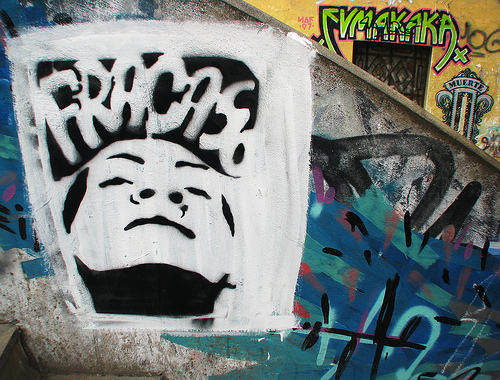
Photo by The/Waz. Used following a Creative Commons license. Taken from http://www.flickr.com/photos/thewaz/2696394170/in/set-72157605789705430/
Internet users preserve art because photographed walls neither wash away, nor decay with time. They can also provide information of the artist's name or pseudonym, location, description, and put the art into context. In a group about Peruvian graffiti on Flickr, there is a discussion about the short careers of the artists, user DeCe-RTOR pointed out some of social responsibilities [es] of the street art in Perú:
el arte en peru necesita una reforma, pues a tenido siempre rupturas como terrorismo, corrupcion, mal sistema educativo y sobretodo pobreza,, asi con todos esos problemas es q no se avanza en ningun sentido, asi no se desarrolla ni cagando este pais, y el arte va tan de la mano con el desarrollo q si no se cultiva este pues no se puede esperar mucho, quienes tienen claro q es el graffiti y lo hacen espero q tengan conciencia del poder q es estar en la calle, por lo tanto hay q tomarlo con responsabilidad y aveces para hacer lo mejor es necesario hacer sacrificios, aveces dejando de pintar egocentricamente lo que uno desea, lo q uno solo puede entender.. y dedicar esas fuerzas y ganas en representar lo que la comunidad quiere ver, y necesita saber… siempre buscando la manera de que ademas q guste a todos, guste a uno,, ahi esta la chamba…
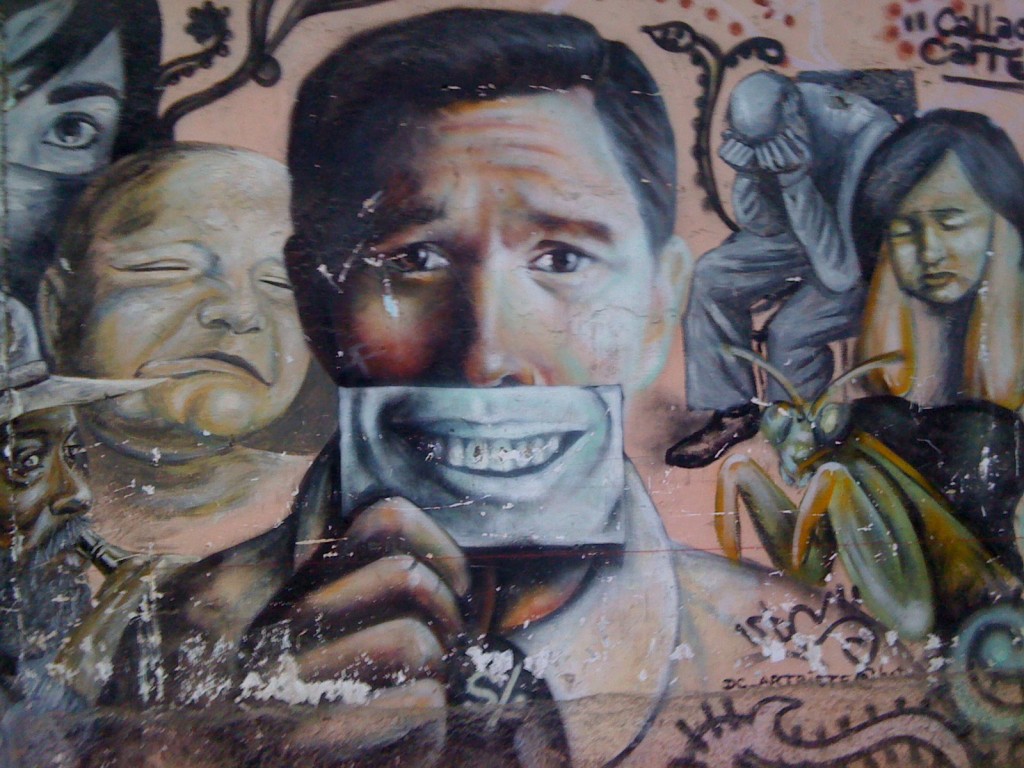
Photo by Luis Fonseca. Used with permission. Taken from http://cazadordegraffitis.blogspot.com/2008/11/sentimientos-ocultos.html
On a more personal level, blogger Luis Fonseca wanders through the streets of Lima taking pictures of urban art, which he shares in his blog Cazador de graffitis [es] with songs, poetry, and reflections on the works like the one shown above [es]:
Iba en el bus un poco mal por cosas de la vida y pensaba que nadie la podía estar pasando peor que yo. Levante la mirada y vi esta imagen en un muro [es], rapidamente pense que mi problema no era nada a comparación de otras personas que viven más tiempo sumergidos en problemas que en paz.
Sometimes the communication is even more direct: graffiti artists like Faber take advantage of the anonymity the electronic media grants to promote their work, to show by themselves and their portfolio without any risk of being prosecuted. With minimal commentaries (“busca la sencillez de las cosas” / “look for the simplicity in things”), Faber shares through Flickr and Fotolog [es] his colorful portraits of sad characters, some of them in poverty, without revealing much of himself except his incredible abilities to create:
Related work can be found on the groups of Flickr Peruvian graffiti and Peruvian street art.
Colombia
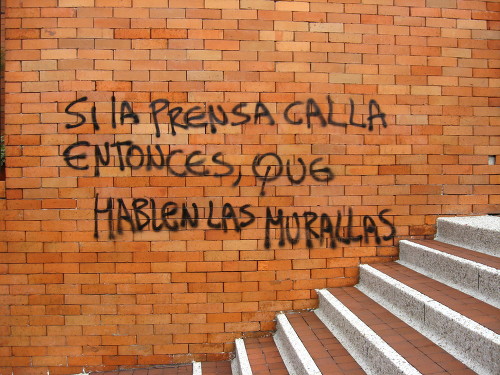
It reads If the press makes silence, then walls should speak. Photo by Juan Arellano. Used with permission. Taken from http://es.zooomr.com/photos/cyberjuan/8272064/
Common graffiti is known for being a ‘code’: only members of the neighborhoods can understand the intricate traces and calligraphy, the “wild style”, or the code numbers used to represent names and places. However, along with these obscure messages, explicit messages can also be found on the streets, using clear and spaced letters, leaning towards protest. On his blog Globalizado [es], Peruvian blogger Juan Arellano shares photos of the graffiti he found in Pasto, Colombia, and he concedes that most of the times he does not understand it:
En realidad no soy tan aficionado a los graffitis, la mayor parte de veces ni siquiera entiendo que dicen dada la complicada grafía que utilizan muchos de los graffiteros, pero cuando el mensaje va claro y directo obviamente que si.
An extensive gallery of explicit graffiti can be found on El Blog Canalla [es], where El Reticente [es] and Alejandro [es] collect politically oriented street art on the streets of Medellín. Although they barely comment on their collection, their slogan holds a message of protest:
Si los medios son del Estado, las paredes son Nuestras
This is a photo taken in the streets of Bogotá, that reads “Huya, lucha, y vuelve a nacer” (“Run away, fight, and be born again”):
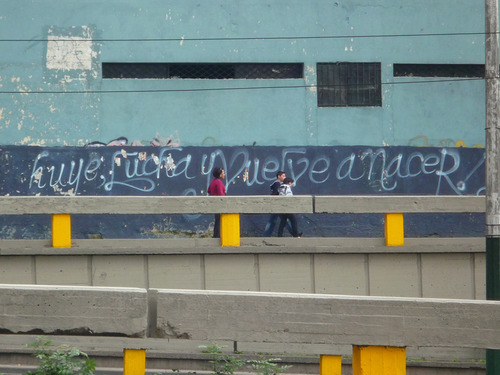
Photo by El blog Canalla. Used with permission. Taken from http://elblogcanalla.tumblr.com/post/290759594/huye-lucha-y-vuelve-a-nacer-bogota-colombia
Flickr groups for urban art of the cities of Cali and Bogotá share photos from almost 300 members altogether.
Guatemala
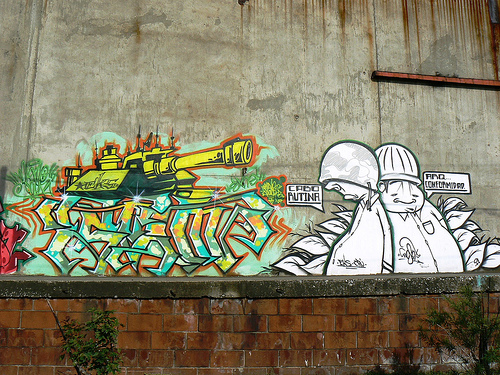
Photo by Oscar Mota. Used following a Creative Commons license. Taken from http://www.flickr.com/photos/oscarmota/1132340373/in/set-72157601472161317/
“Writers” is how graffiti artists call themselves because of their use of quick signatures (called tags) and bombed letters (known as bombs). In the case of Ricardo (alias NEARsyx [es]), he is a grafitti writer, and also a blogger at Hemisferio Urbano [es] he shares events, profiles of other graffiti artists, gathers media coverage of the movement, and also sums up the feeling of his graffiti crews and the community.
In 2007, he documented the situation of the graffiti in Guatemala [es] and criticized how television coverage does not differentiate “artistic” graffiti from “vandal” graffiti, the latter commonly associated with illegal tags and bombs:
Lastimosamente aquí, y creo que en muchos otros lugares, el graffiti aun se asocia bastante a las pandillas, un claro ejemplo de esto es un pequeño documental que recientemente realizo Noti7, un noticiero local, donde la edición de este fue parte crucial para dejar a todo mundo bastante confundido y con la misma imagen de que el graffiti es de pandilleros.
En el documental aparecen algunos de los que si realmente forman parte del movimiento artístico, lo malo es que las imágenes de piezas y entrevistas con ellos fueron mezcladas con imágenes del graffiti pandillero, algo que nos dejo con una mal sabor de boca a todos los que formamos parte de la verdadera comunidad del graff.
Sadly here, and I think in other places too, graffiti is commonly associated with gangs, a clear example of this is a recent documentary made by Noti7, a local news show, where the video was edited in a way that left the audience in confusion and holding the same idea that the graffiti is for vandals.
In the documentary, some appeared that really do belong to the artistic movement, the bad thing is that the pictures of the [graffiti] pieces and the interviews they did were mixed with the images of the graffiti vandalism, something that left a bitter taste for us, who belong to the real community of graffiti.
Nonetheless, both artistic and “non-artistic” graffiti share walls and prolonged murals as shown in the video from user Artesinley of some streets in Guatemala City:
More images from the urban art of Guatemala can be found on Flickr in the Graffiti Guatemalteco group and Hemisferio urbano's account.







26 comments
Dear Issa, thank you very much for the article. I was mapping street art and graffiti in the South Caucasus. I launched a project http://www.street-language.com/ to collect different street messages. I’m open to any kind of collaboration! Please write me if you’re interested.
Thank you, I will surely check your project.
Great post and something I wish we had more of in the South Caucasus. Alexey, interesting about your project, although there’s not much in Armenia.
However, you might be interested in the following.
Now imprisoned blogging Azeri youth activist Adnan Hajizade on graffiti in Baku as well as a graffiti flash mob OL! organized.
http://www.youtube.com/watch?v=6KxjL4DK9PE
http://www.youtube.com/watch?v=u8XZP1YhJWY
Also, an Armenian site on graffiti:
http://community.livejournal.com/graffiti_am/
Hi Issa!
The graffiti are a cultural expression that is part of human communication, but the authorities do not see very well in Colombia because it stains the walls as well as that usually is against the current government. This is certainly Realizing the ideology is free expression.
Excellent post.
¡Best regards and happy new year!
Of course! It is difficult to imagine a system that cheerfully receives controversial and open criticism on the streets. We have to find our ways (as wild as they can be) to communicate what we need to communicate.
Dear Issa,
Your article I found very stimulating to reflect on and respond to the subversive power of art when it comes out strongly in the street or your emplezamiento makes it perfect.
The street is democracy itself, since it is the first public instance in which citizens are expressed (or should be able to) freely: all passersby can see these messages which are the graffiti complaint and thereby participate in citizenship conscious, engaged view the reality and active on political, social, economic, educational, … their respective countries.
That is why I consider that the street art contributes enormously, both by the strength of his instrument, graffiti or “discourses in images”, for the chosen space to translate, at the creation of a collective civic consciousness essential to activate changes policies of any country in the world.